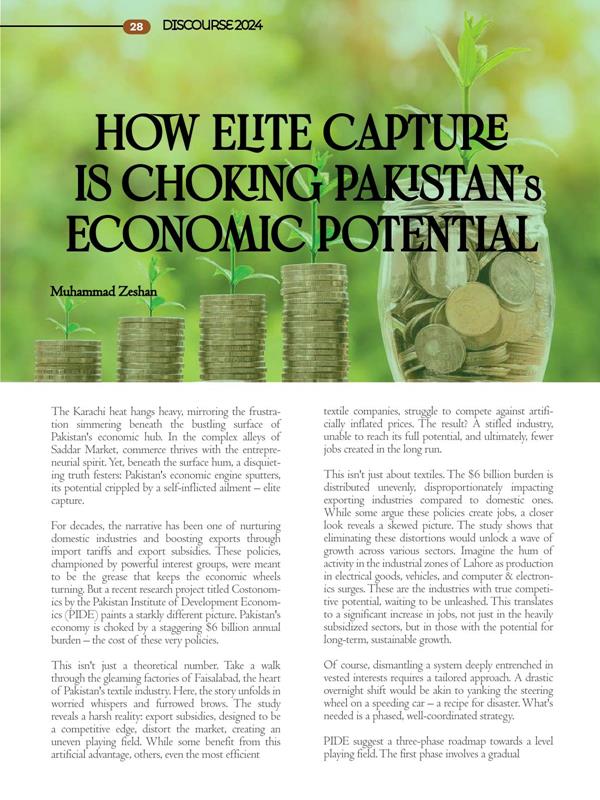
Pakistan Institute of Development Economics
- Home
Our Portals
MenuMenuMenuMenuMenuMenuMenu - ResearchMenuMenuMenuMenuMenuMenuMenu
- Discourse
- The PDR
- Our Researchers
- Academics
- Degree Verification
- Thesis Portal
- Our Portals
How Elite Capture is Choking Pakistan’s Economic Potential
The Karachi heat hangs heavy, mirroring the frustration simmering beneath the bustling surface of Pakistan’s economic hub. In the complex alleys of Saddar Market, commerce thrives with the entrepreneurial spirit. Yet, beneath the surface hum, a disquieting truth festers: Pakistan’s economic engine sputters, its potential crippled by a self-inflicted ailment – elite capture.
For decades, the narrative has been one of nurturing domestic industries and boosting exports through import tariffs and export subsidies. These policies, championed by powerful interest groups, were meant to be the grease that keeps the economic wheels turning. But a recent research project titled Costonomics by the Pakistan Institute of Development Economics (PIDE) paints a starkly different picture. Pakistan’s economy is choked by a staggering $6 billion annual burden – the cost of these very policies.
This isn’t just a theoretical number. Take a walk through the gleaming factories of Faisalabad, the heart of Pakistan’s textile industry. Here, the story unfolds in worried whispers and furrowed brows. The study reveals a harsh reality: export subsidies, designed to be a competitive edge, distort the market, creating an uneven playing field. While some benefit from this artificial advantage, others, even the most efficient textile companies, struggle to compete against artificially inflated prices. The result? A stifled industry, unable to reach its full potential, and ultimately, fewer jobs created in the long run.
This isn’t just about textiles. The $6 billion burden is distributed unevenly, disproportionately impacting exporting industries compared to domestic ones. While some argue these policies create jobs, a closer look reveals a skewed picture. The study shows that eliminating these distortions would unlock a wave of growth across various sectors. Imagine the hum of activity in the industrial zones of Lahore as production in electrical goods, vehicles, and computer & electronics surges. These are the industries with true competitive potential, waiting to be unleashed. This translates to a significant increase in jobs, not just in the heavily subsidized sectors, but in those with the potential for long-term, sustainable growth.
Of course, dismantling a system deeply entrenched in vested interests requires a tailored approach. A drastic overnight shift would be akin to yanking the steering wheel on a speeding car – a recipe for disaster. What’s needed is a phased, well-coordinated strategy.
PIDE suggest a three-phase roadmap towards a level playing field. The first phase involves a gradual reduction of tariffs and subsidies on key intermediate raw materials and heavily subsidized exports. This initial step, spread over three years, allows businesses to adjust and adapt to the changing environment. The second phase, a one-year period, maintains the uniform tariff and subsidy rates achieved in the first phase, providing a period of stability. Finally, the third and final phase acts like a gear shift, completely eliminating all tariffs and subsidies, and allowing the engine to run at full capacity.
But this journey requires more than just tweaking the economic engine. Bureaucratic red tape – the bane of countless entrepreneurs – acts as a handbrake, slowing down progress. Imagine the frustration of a young entrepreneur in Karachi, her innovative tech startup bogged down by permits and approvals. Streamlining non-tariff barriers and simplifying bureaucratic processes would be akin to removing the handbrake, allowing businesses to accelerate towards their goals.
Some might argue that dismantling these policies could hurt established industries. However, the evidence suggests otherwise. The study shows that eliminating distortions fosters a more competitive environment, one that rewards innovation and efficiency. Imagine the bustling workshops of Sialkot, the heart of Pakistan’s sporting goods industry. Here, with a level playing field, smaller, more agile companies can compete with established giants, pushing the boundaries of design and quality. This, in turn, strengthens the overall industry, creating a virtuous cycle of growth and job creation.
The path forward isn’t without its challenges. Powerful interest groups who benefit from the current system will resist change. There will be bumps along the road, adjustments to be made. But the alternative – clinging to a flawed system – is akin to driving with a flat tire. It may get you there eventually, but the journey will be far more arduous, the destination much further away.
Pakistan’s story is not one of a broken engine; it’s one of a deliberately tampered one. The shackles of elite capture have held back our economic potential for far too long. By dismantling this system, we can unleash the true power of our industries, create a dynamic job market that rewards innovation and hard work, and finally shift gears towards a future of sustainable economic growth. The choice is ours: remain stuck in a cycle of stagnation, or unleash the power within, and transform Karachi’s bustling streets into a testament to Pakistan’s true economic potential.
Hence, we suggest a coordinated approach as a way forward:
- Phase-out approach: This is a three-phase (five year) scenario. In the first (three year) phase, reduce import tariffs on the most protected intermediate raw materials also cut the export subsidies on the most protected exporting industries, until the tariff and subsidy rates in all the trade lines converge to their respective averages.
- Second (one year) phase: Maintain the uniform tariff on and subsidy rate on all the trade lines (the targeted averages).
- Third (one year) phase: Uniformly eliminate the tariffs and subsidies on all industries.
- Comprehensive policy overhaul: Streamline non-tariff barriers, bureaucratic processes, enhance trade facilitation mechanisms, and fortify institutional frameworks to amplify the benefits of competitiveness.



